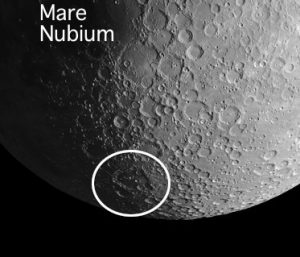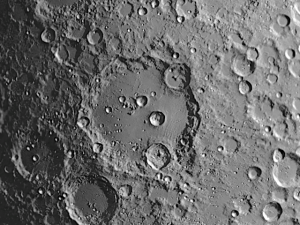The week of Jan. 14-20 takes us from Day 8 to Day 14. This week we will highlight the crater Clavius.
 Clavius: [SW/Q8] If you catch the Moon early in Day 8 when the terminator is around 15° (i.e., it cuts right through Clavius), and if you have determined that you can see objects that are as small as 2 arc-minutes with the naked eye1, look at the Moon without benefit of telescope or binoculars and you might be able to see a small notch that has been chiseled out of the terminator in the southern portion of the Moon. This notch is the crater Clavius. If you need to, double-check with binoculars then go back and see if you can detect it with your naked eyes. Come back tomorrow night to see Clavius in its full glory.
Clavius: [SW/Q8] If you catch the Moon early in Day 8 when the terminator is around 15° (i.e., it cuts right through Clavius), and if you have determined that you can see objects that are as small as 2 arc-minutes with the naked eye1, look at the Moon without benefit of telescope or binoculars and you might be able to see a small notch that has been chiseled out of the terminator in the southern portion of the Moon. This notch is the crater Clavius. If you need to, double-check with binoculars then go back and see if you can detect it with your naked eyes. Come back tomorrow night to see Clavius in its full glory.

 Sunrise over Clavius is something that you don’t want to miss! The crater is so large (140 miles) that the curvature of the Moon pushes the floor’s central regions into the sunlight first. As the day progresses, the shadows will retreat to reveal a floor that is strewn with craterlets. There is a delightful arc of small craters, artistically and sequentially arranged in order of size, which begins at Rutherfurd, a 34-mile crater just inside the southeast rim, arcs northward and then diminishes toward the west. (You may have to wait until tomorrow night to see the entire sequence.) While the Sun angle is low over Clavius, look for several ridges that extend like fingers northward from Rutherfurd. The origin of these ridges remains a mystery. Revisit Clavius often. You will always see something that you missed previously.
Sunrise over Clavius is something that you don’t want to miss! The crater is so large (140 miles) that the curvature of the Moon pushes the floor’s central regions into the sunlight first. As the day progresses, the shadows will retreat to reveal a floor that is strewn with craterlets. There is a delightful arc of small craters, artistically and sequentially arranged in order of size, which begins at Rutherfurd, a 34-mile crater just inside the southeast rim, arcs northward and then diminishes toward the west. (You may have to wait until tomorrow night to see the entire sequence.) While the Sun angle is low over Clavius, look for several ridges that extend like fingers northward from Rutherfurd. The origin of these ridges remains a mystery. Revisit Clavius often. You will always see something that you missed previously.
OF ADDITIONAL INTEREST ABOUT THE MOON:
Great news: There will be a total lunar eclipse (frequently called a “blood moon”), on Sunday, Jan. 20, visible from the entire United States! It begins on the east coast around 9:40 EST, and totality will be just after midnight.
Many people are surprised that the Moon is not totally black in mid-eclipse, but glows red. During a full eclipse the Earth’s atmosphere acts like a lens and will refract (i.e., bend) light from the Sun onto the surface of what would otherwise be a dark Moon caught in the Earth’s shadow. As a result, you will see the red glow of every sunrise and sunset around the Earth eerily illuminating the surface of the Moon, hence the term “blood moon.”
======================
It is highly recommended that you get a copy of Sky and Telescope’s Field Map of the Moon, the very finest Moon map available for use at the telescope. It is available for $10.95 at www.skyandtelescope.com and on Amazon. All features mentioned in this blog will be keyed to the grid on the Field Map and will look like this: Plato: [NW/D9]
Credits:
Courtesy of Gray Photography of Corpus Christi, Texas
Lunar photos: NASA / USGS / BMDO / LROC / ASU / DLR / LOLA / Moon Globe. Used by permission
- Rupes Cauchy: A Best Known Fault on the Moon - July 22, 2024
- Moon Crater Schickard – Crater Floor has Stripes - July 15, 2024
- Moon Craters Langrenus and Vandelinus - July 8, 2024
1 For most people, this will vary between two and four arc-minutes.